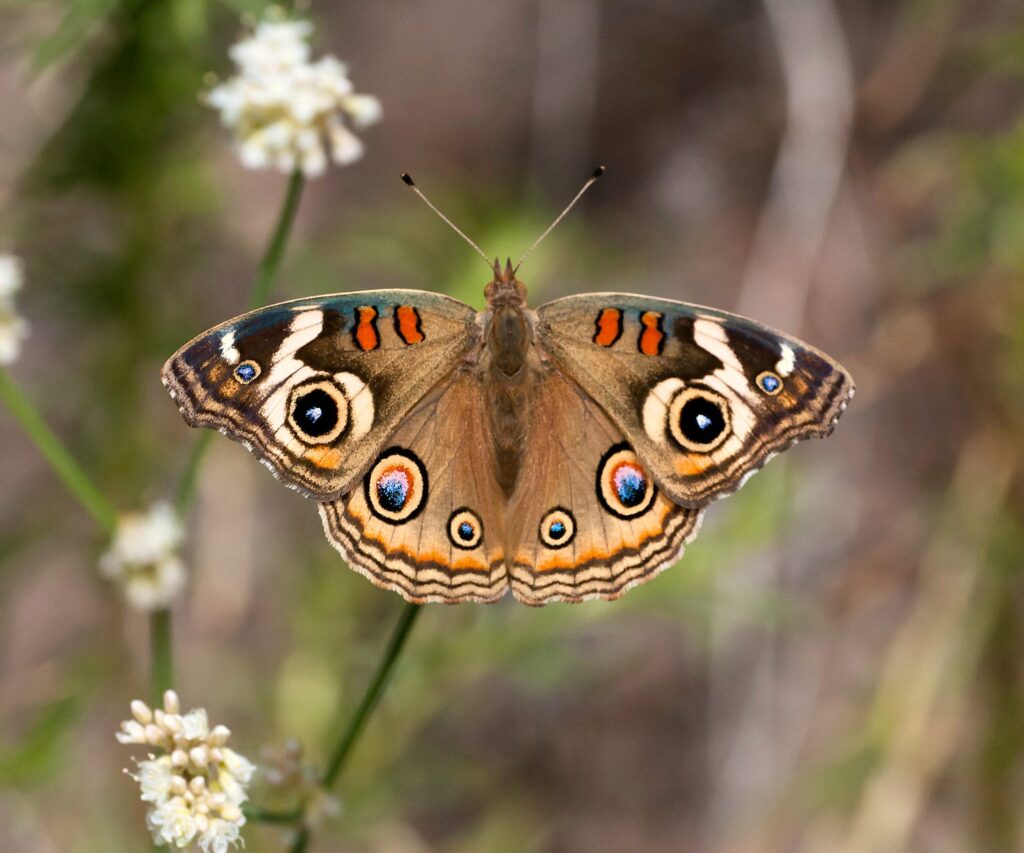Hikers on the well-known Pacific Crest Trail are encouraged to relax at a covered picnic table and fill their water bottle from a well spout when they arrive at Mark Newberger’s land on Mount Ashland.
At 5,500 feet above sea level, tourists also enjoy a front-row seat to Newberger’s award-winning butterfly garden.
Showy milkweed is where monarch butterflies lay their eggs. In the garden, which is less than five miles upslope of California’s northern border, California marble butterflies land on caterpillar host plants, and tower rockcress plants purposefully attract pale swallowtail, echo azure, and Lorquin’s admirals with their small, creamy blooms.
Bees, butterflies, and other helpful pollinators are essential to agriculture, economy, and ecosystems.Pollination is essential to the survival of 85% of all flowering plants, yet habitat loss and pesticide use are endangering pollinator populations.
Here, Newberger aided nature by turning two barren acres surrounding his log home into a thriving native plant garden where pollinators could eat the nectar and caterpillars of the flowers and shelter in the leaves.
In 2024, the editors of Butterfly Gardener, a magazine for members of the North American Butterfly Association, named the site the Butterfly Garden of the Year because of the more than 60 species of butterflies that have been documented there.
“His nature-scaping with native plants has strengthened the area’s wildlife connectivity that development usually interrupts,” said Dianne Keller, who conducts the association’s butterfly count in the large and critical Siskiyou Crest, which includes Newberger’s property.
As part of a high-elevation land bridge to the Pacific Ocean, her report for the organization describes Newberger’s property as a haven for rare flora and wildlife to escape the heat of the lowlands.
Newberger has been working with the Southern Oregon Land Conservancy to create a land conservation easement to save his existing montane white fir forest, montane chaparral, and meadows since acquiring the 40-acre site beneath the Mount Ashland Ski Resort in 2014.
As a certified naturalist via the Oregon State University Extension Service, Newberger has created paths on his property and welcomes groups that are interested in the area’s varied geological, ecological, and floral elements.
Newberger requested Klamath-Siskiyou Native Seeds botanist Suzie Savoie to design a butterfly garden devoid of pesticides nine years ago.
For the garden, Savoie collected seeds from 60 different native plant species. Along with native grasses and buckwheats, there are various varieties of lupines.
In order to teach people about wild landscapes and demonstrate how wildcrafted seeds might replicate the advantages in a home garden, Savoie will lead a half-mile walk on the Pacific Crest Trail from Mount Ashland’s Grouse Gap picnic spot to Newberger’s farm on July 6.
The nonprofit organization Pollinator Project Rogue Valley is hosting the walking workshop, Wild Inspiration: Observing Nature for Native Plant Garden Design. Tickets can be purchased at pollinatorprojectroguevalley.org for $20.
Newberger claimed that in order to support pollinators, he did not sacrifice the aesthetic appeal of a beautiful setting. A robust canvas of purpleflower honeysuckle, Oregon sunshine, and red paintbrush is present.
Near tall cream-colored beargrass and yellow arrowleaf mule’s ears are mountain blue penstemons.
“You don’t have to deny yourself beauty, joy, and awe and wonder,” he remarked.
Savoie collected Newberger’s self-seeding native plants in the area to match the genetics of the land at this height, and they don’t need water or care. However, he constantly keeps a close eye out for invasive weeds, pausing in the middle of sentences to pluck a yellow salsify.
“Oh, boy,” he remarked, “that shouldn’t be here at all.” Although I have done some weeding here, this area has the greatest species diversity and a strong natural defense against invasive plants.
Rob Santry, a photographer from Grants Pass, frequently visits here on chilly mornings. He employs patience and a Nikon camera to take pictures of butterflies such as the female golden hairstreak depositing an egg on the underside of a golden chinquipin, a caterpillar host plant, the aclodius parnassians sleeping on a bleeding heart herb, and the ahydaspe fritillary consuming nectar.
Newberger welcomed Santry into the property after spotting him taking pictures along the Mount Ashland Ski Road.
Volunteering for the butterfly count and taking pictures to record sightings of lilac bordered copper, cedar hairstreak, and other butterflies is Ashland photographer David Lee Myers, author of Wings in the Light: Wild Butterflies in North America.
According to 72-year-old Newberger, “not many things in my life have surpassed my expectations, and this is one because the garden keeps getting better and better and every year is so different.”
The Land
Part of the expansive Siskiyou Crest is Mount Ashland.Coalition of Siskiyou Crest
Newberger’s Land is a tiny but important point on the Siskiyou Crest, a natural area that connects the Oregon and Northern California coast ranges with the volcanic Cascade.
According to the organization Siskiyou Crest Coalition, the West Coast’s biodiversity is centered on the remarkably steep ridgelines, deep valleys, and rivers that are home to ancient species.
The Takelma, Shasta, and other Indigenous peoples, including certain members of the Confederated Tribes of Grand Ronde, have an ancestral territory where wildlife has roamed the sky, forests, and waterways for millions of years.
Savoie trekked almost 200 miles across the Siskiyou Crest wildlands in the summer of 2019 with her companion, Luke Ruediger, author of The Siskiyou Crest: Hikes, History & Ecology.
Ten days later, they came to an end on the Pacific Ocean coastlines south of Crescent City, California, having begun on the western side of the Cascade-Siskiyou National Monument above Ashland.
The area that serves as inspiration for their work is highlighted in the movie Sagebrush to Sea: A Journey Across the Siskiyou Crest, which chronicles their trek.
Pollinator garden tips
Although June 16–22 is National Pollinator Week, beneficial insects require assistance all year round.
Are you prepared to begin attracting pollinators such as butterflies to your home garden?
Growing a range of native plants that offer butterflies, moths, bees, wasps, and hummingbirds year-round nectar and pollen is advised by experts. A variety of flower colors, shapes, and sizes is ideal. Shelter can also be provided by larger plants.
Begin modestly. Depending on whether your yard is sunny, shaded, or moist, buy a few native plants that will flourish there. In addition to a teaching center, propagation nursery, and demonstration garden in the city of Phoenix, southern Oregon, the nonprofit Pollinator Project Rogue Valley also maintains online resource information.
Above all, avoid using chemicals. According to the group, instead, take pleasure in the organic cycle of insects eating plants and birds eating bugs.
A list of 25 plants that attract native bees may be found at OregonLive.com, along with a 40-page guide to pollinator gardens called Enhancing Urban and Suburban Landscapes to Protect Pollinators, which is available for download from the OSU Extension Service.
OSU Extension Service experts have discovered that butterflies favor:
-
Red, orange, yellow and purple flowers.
-
Flat flowers shaped like coreopsis.
-
Small flowers in clusters such as milkweed, catmint and lupine.
Bees favor:
-
White, yellow, purple and blue flowers.
-
Flat flowers shaped like berry bloom.
-
Tiny flowers in clusters such as sedum, ninebark and milkweed.
Choose a site that draws the desired pollinator, according to the U.S. Fish and Wildlife Services.
-
Butterflies and other pollinators like to bask in the sun and some of their favorite wildflowers grow best in full or partial sun with some protection from the wind.
-
Know the soil type. Turn over a test patch to see if it s sandy and well-drained or more clay-like and wet. The soil type and the amount of sunlight will help determine the kinds of plants that can grow there.
-
Research which varieties ofmilkweed and wildflowers
are native to the area and do well in your soil and sunlight conditions.
-
Native plants are the ideal choice because they require less maintenance and tend to be hardier. Find a local nursery that specializes in native plants.
-
It s essential to choose plants that have not been treated with pesticides, insecticides or neonicotinoids.
-
You ll also want to focus on selecting perennials to ensure your plants come back each year and don t require a lot of maintenance.
Janet Eastman writes on trends and design. You can follow her on X@janeteastman and contact her at 503-294-4072 and jeastman@oregonian.com.





More Stories
How an Oregon garden is saving butterflies and creating a wildlife ‘land bridge’ at 5,500 feet
How an Oregon garden is saving butterflies and creating a wildlife ‘land bridge’ at 5,500 feet
How an Oregon garden is saving butterflies and creating a wildlife ‘land bridge’ at 5,500 feet